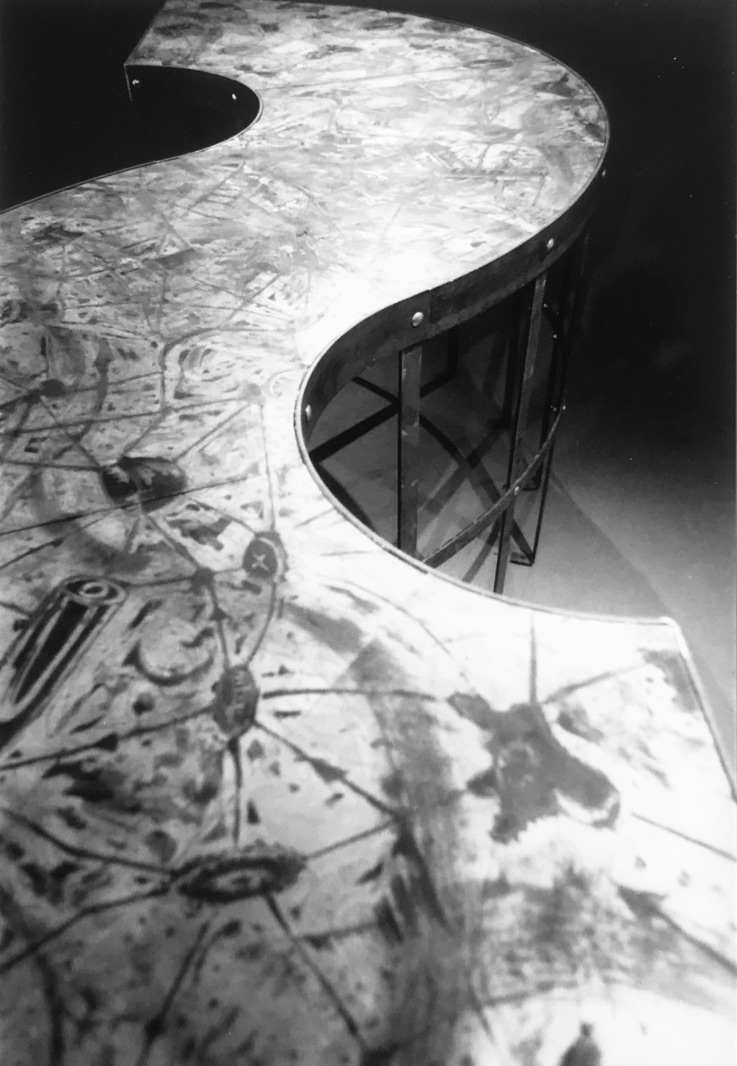|
| roland schärwork |
curriculum vitae |
exhibition views |
bibliography |
friends |
| |
le parvis - centre d'art contemporain - ibos/tarbes (avril/mai 1998)
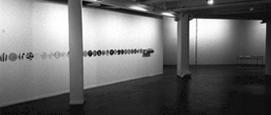
forage: creusons l'avenir (à gauche), incision, table d'hypothèses (au fond)
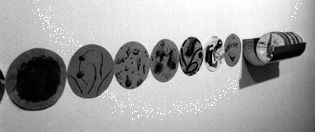
forage : creusons l'avenir : ensemble de dessins sur papiers ronds, présenté sur un support évoquant des carottes de forages géologiques. chaque dessin est daté au dos d'une date anticipée, pour le projeter vers l'avenir. cet ensemble est pensé comme un lieu de réflexion à des projets à venir : croquis, notes, etc, un espace de projections et de recherche.
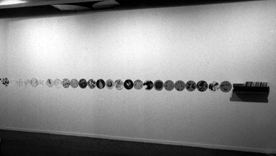
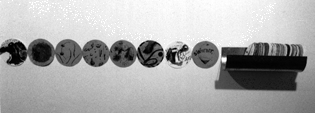

peinture, incision, la table d'hypothèses
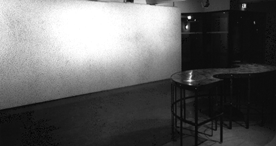
les particules (dessin mural), la table des migrations
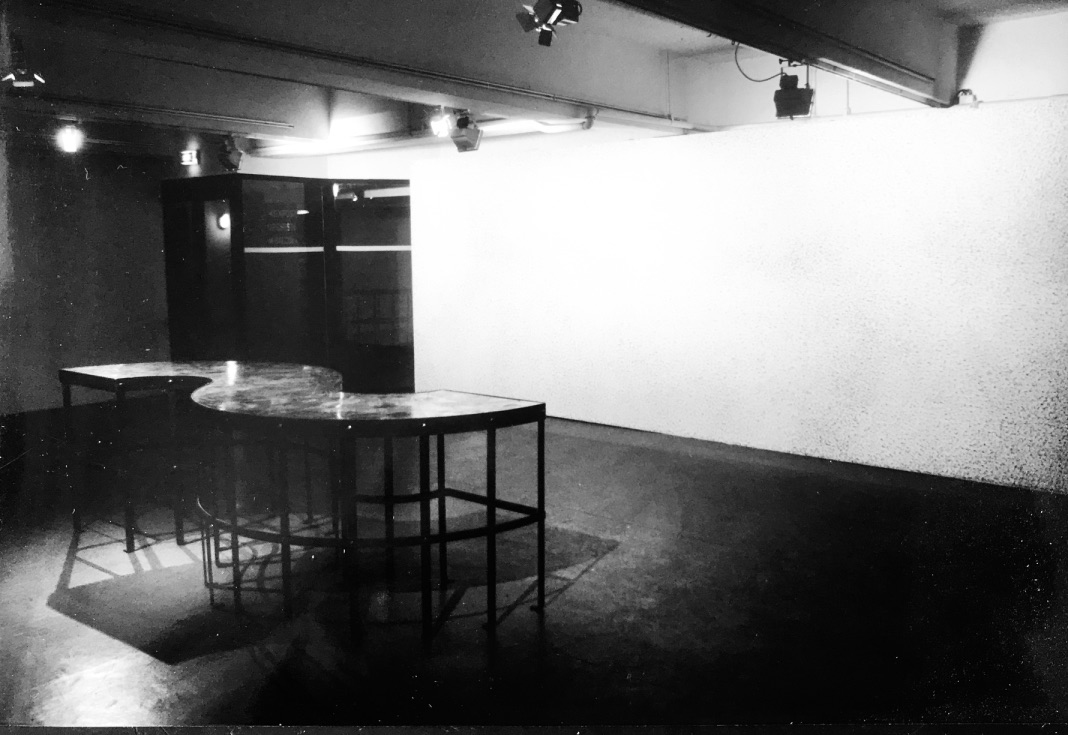
Jean-Marc HUITOREL, "La migration des formes", in: Catalogue d'exposition Le Parvis, Ibos/Tarbes, mars 1998
 Table d'Hypothèses
Dès ses premières oeuvres au début des années 90, Roland Schär revendique clairement son choix de la peinture. De l'huile sur toile avec des titres et des descripteurs qui se référaient avec une certaine ostentation au domaine de la peinture classique: vanité, quadriptique, par exemple. Il s'agit en effet bien de vanités, à tout le moins de natures mortes, sous la forme d'objets accumulés, comme jetés en vrac, un amoncellement si dense qu'à la surface seule des choses la lumière peut s'accrocher. Entre eux, c'est la nuit et l'absence d'air, d'autres objets soupçonnés, le soupçon également d'un possible butoir du monochrome. Les titres, outre le mot Vanité, comprennent, entre parenthèses, un second terme, plus précis, certes, mais qui, néanmoins, correspond à une sorte de catégorie générique, un chapitre d'encyclopédie: (les objets), (la sexualité), (le monde)É Le carré final résulte de l'assemblage de quatre tableaux, carrés eux aussi. Déjà la dialectique des parties et du tout. Déjà le souci d'une organisation ouverte des fragments. La surface, obtenue par l'accumulation si serré des objets, semble montrer la synthèse de tout ce qui, en fait de peinture, a marque si contradictoirement le siècle: dessin précis, assemblage qui, entre l'analyse et l'expression, se réclame tout autant de Pollock, de sa rage patiente d'absorber le all over du tableau. C'est un dripping de dessins, un geste tellement démultiplié, à ce point décomposé dans la précision des détails qu'il témoigne de ce double mouvement, de cette contradiction qu'on croyait insoluble entre la rigueur du dessin et l'emportement du geste. Un peu plus tard, dans l'ensemble Handle with Care (1995), au titre subtilement ironique, Roland Schär utilise des cartons d'emballage comme support et différentes techniques, principalement de l'acrylique, comme médium. Du point de vue chromatique, c'est le noir et blanc qui domine, comme s'il avait souhaité réduire au maximum les effets de couleurs afin que subsistent seuls les objets et l'espace qui les sépare. Il s'agit cependant toujours d'un inventaire chaotique du monde, d'un lieu improbable, quelque part entre la décharge publique et la caverne d'Ali Baba. C'est par-dessus tout une reprise en compte de cette part insigne du destin de la peinture qui est d'envisager le monde. Cet envisagement, nombre d'artistes contemporains s'y attachent. C'est même en cela que réside le plus vivant de l'art d'aujourd'hui, dans cette nouvelle expérimentation du monde menée par une infinité de moyens. Mais là où l'entreprise de Roland Schär fait montre de singularité, c'est quand il choisit pour ce faire la peinture; mieux, la peinture en son exigence originelle, en sa mission primitive. Ce qui se tente ici, dans une totale adéquation aux préoccupations de l'époque, relève, malgré les différentes formes que cela va prendre, malgré l'éventuel renoncement au médium, d'une stricte aventure pricturale. Au gré des investigations qu'il va mener bientôt, toujours Roland Schär revient au corpus établi par les peintures du début, c'est-à-dire à la notion élargie d'objet. Néanmoins la forme, la méthode d'approche, et partant, la définition de ce qu'il entend par objet vont sensiblement évoluer. C'est cette approche du monde, les différents protocoles qui la rendent possible, que nous allons à présent essayer de décrire. Le travail de Roland Schär se fonde sur une exigence spéculative, comme furent spéculatives les oeuvres de Jorge Luis Borges qu'il cite volontiers ou de Georges Perec. Il se réfère également et non sans raison, à Michel Foucault et à Edgar Morin. Méthode et inventaire. Penser/classer. A Paris, Georges Perec habitait rue Linné. Tous s'exercèrent à nommer puis à ranger. Et dans le même temps, on sait à quel point Perec comme Morin se sont méfié de l'ordre. C'est également au croisement de la fascination de la description et de la suspiscion à l'égard des catégories fixes qu'on peut situer l'entreprise de Roland Schär. La pièce charnière, à ce jour, s'intitule Anatomies. Débutée en 1996, elle reste ouverte, l'artiste se réservant la possibilité de l'augmenter. Entièrement déployée au mur, elle se présente sous la forme d'une cinquantaine de groupes de dessins, chacun épinglé verticalement sous une planche d'anatomie, extraite d'un très bel ensemble de lithographies de la fin du XIXème siècle et trouvé aux Puces. Mais l'artiste adopte également d'autres modalités de monstration. Soit il épingle la planche d'anatomie au-dessus d'une boîte en fer blanc où sont glissés les dessins offerts à la consultation, soit c'est la planche qui se trouve dans la boîte et les dessins épinglés. Ces dessins ne laissent pas d'intriguer. Parfois ils évoquent des formes ou des objets connus mais ils ne leur correspondent jamais vraiment. Ils ne représentent pas. Ils résultent en effet d'un processus étonnant. Aux quatre coins d'une feuille, Roland Schär dessins un objet différent mais parfaitement identifié, le plus souvent banal: un radar, un avion, un coeur et un miroir; une canne, des lunettes, une fleur et une cloche, etc. Puis, d'un objet à l'autre et par tous les chemins (horizontaux, verticaux, diagonaux), il pose les formes intermédiaires de l'évolution plastique (morphing) de l'objet A vers l'objet B, un peu à la manière des glissements des dessins physiognomiques de Le Brun. Ainsi, au centre de la feuille, à l'intersection des diagonales, il obtient un dessin qui est la synthèse des cheminements, qui tient un peut de chacune des quatre formes originelles sans être pour autant réductible à quoi que ce soit. C'est cela qu'il reporte, à la plume, au lavis ou selon d'autres techniques sur des feuilles de différents papiers et de couleurs variables au bas desquelles, parfois en différentes langues, sont inscrits les noms des quatre objets de départ. Ce qui l'intéresse ici, c'est l'espace entre les choses, ce qu'il appelle très joliment "la migration des formes les unes vers les autres". mais il s'agit d'itinéraires souterrains, du corps intérieur et secret de la peinture, quelque chose qui hésiterait entre l'origine et l'aboutissement. Cette question de l'intervalle, de la contreforme, se trouve au coeur des préoccupations des peintre depuis Masaccio et Piero mais personne, à ma connaissance, n'en avait rendu compte de cette manière. Une fois les formes posées, vient le temps des rapprochements et du classements. Cette impossibilité à désigner (objets innommables), Roland Schär la compense par la taxinomie, par la création d'ensembles subjectifs mais qui, tous, reposent sur les parentés formelles. Il obtient ainsi des familles inédites constituant un monde insoupçonné, une sorte d'alternative. Car au-delà du jeu d'invention, il s'agit bien ici d'interroger les catégories admises, celles du langage et de ses conventions en premier lieu, celles aussi de l'idée qu'on se fait des choses, c'est-à-dire de la représentation. Dans cette perspective, l'articulation avec les planches anatomiques fonctionne comme une métaphore, comme l'image même de nos représentations conventionnelles, de nos innombrables cartographies, de toutes les apparences que revêt notre appréhension du monde. Cette inscription verticale de formes allusives rappelle étrangement les écritures à idéogrammes et pictogrammes. L'approche opérée par Roland Schär conserve évidemment une part importante de rêverie poétique et sa méthode reste largment subjective et aléatoire. Il se peut, par exemple, que l'ordre des regroupements autant que leur contenu change d'un accrochage à l'autre. Il n'empêche que son intuition peut à juste titre revendiquer une dimension spéculative et en ce sens, la présence des planches anatomiques comme repères de classification a posteriori participe totalement de la logique de l'oeuvre. Cette intuition repose largement sur la conviction qu'entre les choses et entre les gens, plutôt que le vide, gît un potentiel de formes, une réalité mouvante et souple qu'il s'agit d'informer. C'est ce protocole d'information qui sous-tend les autres réalisation de Roland Schär et en tout premier lieu ses Tables d'hypothèses, exemple-type de la volonté d'information que nous évoquions à l'instant. Sur un plateau en alluminium conçu par lui et qui évoque la table de dissection, sont disposées différentes formes réalisées à base de savon, de cire et de parafine. C'est la traduction tridimensionnelle des dessins d'anatomies. Au visiteur de les agencer, de les classer selon ses propres critères: il ne s'en prive pas. Cette réification produit plus de trouble encore que les dessins tant ces objets témoignent de synthèses plastiques autant que d'inconscient formel et culturel, d'anthropologie imaginaire. Ces objets présentés sur la table semblaient provenir d'un monde tout proche mais que l'on n'aurait pas retenu dans les conventions de la représentation. On voit en effet à quel point il frôle le réel officiel quand Roland Schär place sa table à côté de peintures récentes où le contour des choses s'est visiblement atténué par rapport aux tableaux plus anciens, cédant la priorité aux agencements et aux textures. C'est l'idée de ce magma entrevu qui préside à la pose, à même le mur, d'un dessin très étroit et allongé, comme une incision, un geste qui, en ces temps où se tentent de nouvelles figurations, peut être perçue comme un équivalent actuel des incisions modernistes de Lucio Fontana. Cette exploration des interstices, cette investigation du continuum de la réalité, Roland Schär l'étend à de grandes surfaces, des murs entiers qu'il recouvre de minuscules traits d'encre de Chine apposés à l'aide d'une plume de pigeon. L'espace se voit ainsi investi d'une apparence de matière plus ou moins dense, d'un étoîlement de particules qui finit par faire perdre à l'oeil tous ses repères. Cette autre modalité de la surface peinte, qui excède largement la notion même de tableau, apparaît à la fois comme une réflexion sur l'espace et sur la matière de la peinture. Le plan s'y émeut en des perspectives fluctuantes où les effets visuels de l'op art se verraient confrontés à l'expérience de l'in situ. Cette seconde alternative à la perception habituelle, déstabilisante en diable, l'artiste feint de la compenser par la présence toute proche d'une table de désorientation, ronde, en demi-cercle ou bien en S et sur laquelle le visiteur peut lire un certain nombre d'informations gravées sur des plaques de zinc. Mais il ne s'agit là encore, sous des formes variables, que d'énoncés discontinus, nouveaux espaces intermédiaires, nouvelles migrations. Au mur, d'autres intervalles, magmas météorologiques, ciels improbables peints sur des tondos en matière non tissée, comme en écho au rond des tables, au chaos des particules. Si l'on considère que chaque ensemble des travaux de Roland Schär reste un work in progress, on pourrait dire que, tout comme d'autres artistes d'aujourd'hui, il ne peint pas de tableaux récents. Le temps, chez lui, relève plus de l'espace que de la chronologie et quand il aligne les dates, il convient de faire preuve de la plus grande vigilance. Soit l'oeuvre intitulée Forage: creusons l'avenir. Depuis mars 97, Roland Schär utilise des papiers de forme ronde d'environ vingt centimètres de diamètre comme supports de croquis, dessins, notes manuscrites, projets, etc. Le premier remonte au 24 mars, jour à partir duquel il appose au dos de chaque rond une date chronologique. Ce serait parfait s'il ne réalisait qu'un document par jour. Malheureusement, le rythme en est bien plus élevé, si bien, que très rapidement le calendrier s'est emballé et que, par exemple, les derniers ronds, aujourd'hui 6 février, portent une date de 1999. Une partie est déployée à l'horizontale sur le mur, l'autre est placée à la perpendiculaire, comme on range les livres, dans une sorte de gouttière, donnant ici encore la possibilité au visiteur de les consulter. Perturbation de l'espace, agitation du temps; le temps saisi dans l'épaisseur des actes quotidiens, le temps intensifié et non plus étale mais dans un choix au bout du compte aussi crédible que celui des découpages qui rythment nos vies: l'épaisseur du temps. Ici, comme depuis l'origine de son entreprise, Roland Schär explore inlassablement ces non-lieux que cache la dictature du topos et qui, révélés par des écrits inédits de peinture, font de cette dernière cela qu'elle n'a jamais cessé d'être: une merveilleuse utopie.
Jean-Marc HUITOREL, "The Migration of Forms", in: catalog Le Parvis, Ibos/Tarbes, march 1998
Since his ealiest works at the beginning of th 90's, Roland Schär clearly lays claim to his choice of medium - oil painting. His oils on canvas described as "quadriptych" or "vanitas" evoke, with a certain boldness, a classic period. That they are indeed vanitas paintings, or, at the very least, "still life" compositions of objects seemingly thrown together haphazardly. The jumble of objects is so dense that the light is only able to catch at the surface of things. In between them it is dark and airless; one guesses at other objects and suspects that herein, possibly, lies the ultimate limits of monochrome. Apart from "vanitas", the titles of his paintings include a term which is places in brackets and which, although more precise than "vanitas", nonetheless refers to a general classification such as is found in the chapter headings of an encyclopedia: (les objets), (la sexualité), (le monde) ... The "quadriptych" is the result of the assembly of four pictures which are themselves square. Here already we see the dialectics between the parts and the whole; we can already see appear the artists concern with a liberal arrangement of the fragments. The surface, achieves through the objects amassed so tightly together, seems to present us with the synthesis of everything which has marked this century, with so much contradiction within the painting domain; defined drawing, assemblage which in its oscillation between analysis and expression evokes, as much as Pollock, a stubborn passion to absorb the "all over" of the painting. It is a "dripping" of drawings, a gesture so fractured, broken down to such a point in its attention to detail, that is testifies to this double movement - thought to be insoluble - that is, the contradiction between the rigour of drawing and the flow of movement. Further on, in the Handle with Care (1995) collection (an ironic title), Roland Schär uses packing cardboard as his canvas and different techniques, mainly acrylic, as his medium. From the chromatic point of view, black and white dominate. It is as if he wished to reduce to the minimum the effects of colour so that the objects and the space which separates them remain alone. Is is still, nonetheless, a chaotic inventory of the world, an unlikely place - somewhere between a public dump and Ali Baba's grotto. Above all he recaptures painting's noteworthy destiny which many contemporary artists adhere to. Indeed today's most dynamic art resides within the expression of such contemplation, in a renewed experience of the world, brought about by an infinite variety of means. The distinctive quality in Roland Schär's work is demonstrated when he chooses painting for that purpose, and further demonstrated when he presents painting in all its original rigour and primitive function. What he is attempting here is a rigourous pictoral adventure, in keeping with the concerns of the time. He does this, despite the different shapes and forms it takes and despite his eventual departure from the medium. Over the course of his subsequent research, Roland Schär comes back to the corpus established through the first paintings, i.e. to the wider concept of the object. Nevertheless, the form, his method of approach and therefore his definition of object evolve noticeably. It is this approach to the world and the different protocols that make it possible, which are described below. Roland Schär's work is based on a speculative rigour, as were those of Jorge Luis Borges', (whom he willingly quotes), or Georges Perec's. He also refers - and not without reason - to Michel Foucault and Edgar Morin: method and inventory; Think/Classify. In Paris, Georges Perec lived in Rue Linné. They all practised naming and classifying and yet it is known to what extent Perec, as indeed Morin, were suspicious of order. It is precisely in this junction between the fascination of classification and the suspicion of fixed categories, that Roland Schär's work can be situated. The turning point, to this day, can be seen in Anatomies. Begun in 1996, it remains "open ended" - the artist reserving the right to add to it. It is desplayed in its entirety on one wall in the form of about 50 groups of drawings. Each one is pinned vetically under an anatomical illustration taken from a very beautiful collection of late 19th century lithographs, found in the flea market. The artist uses other methods of display. Either he pins the anatomical illustration over a white metal box in which the drawings have been placed for viewing; or the illustration is in the box and the drawings are pinned above. These drawings never cease to intrigue. Sometimes, they evoke shapes or familiar objects but they never entirely correspond to them. The drawings are not figurative. They are, in fact, the result of an astonishing process. On each of the four corners of a page, Roland Schär draws a different but perfectly identifiable object, mostly of a banal nature: a radar, an aeroplane, a heart, a mirror; or a walking stick, spectacles, a flower, a bell, etc. He then places, along the lines, (vertical, horizontal, diagonal), which link one object to the other, the intermediary forms of the object's plastic evolution (morphing) from object A to object B. It slightly resemble the shifts in Le Brun's physiognomic drawings. Thus, in the centre of the page at the intersection of the diagonals, Roland Schär obtains a drawing which is the synthesis of these developments. The drawing contains within it something of each of the original four forms, though it cannot itself be reduced to any of these in any way. This is what he transfers onto paper, using pen and ink, wash drawing or using other techniques on coloured papers of different types. At the foot of these, the names of the four starting objects are inscribed, sometimes in different languages. What interests Roland Schär here is the space between things, what he very nicely calls: "the migration of forms from one to the other". It is the world of underground itineraries, the inner secret body of painting, a hesitation between origin and outcome. This question of interval, of counterform lies at the heart of painters' preoccupations since Masaccio and Piere. No-one, however, to my knowledge, has stated it in this way. Once the shapes have been placed, it is time to link and classify them. Roland Schär has made up for the impossibility of naming the objects, (they are nameless objects), through tanonomy: the creation of subjective groupings which all rest on formal relationships. He thus obtains new families, making up a hitherto unsuspected world - a kind of alternative. It is beyond a game of invention. The point, indeed, is to question the accepted categories, those of language and its conventions first of all and then also those respresenting the idea we have of things, that is - the presentation itself. From this perspective, the drawings' connection with anatomical illustrations acts as a metaphor. It acts as the very image of our conventional displays, our countless cartography, of all the illusions which cover up our fear of the world. The vertical inscription of allusive shapes strangely call to mind writing forms which use ideograms and pictograms. The approach used by Roland Schär clearly maintains an important amount of poetic rêverie and his method remains largely subjective and aleatory. It could be, for example, that the grouping order of any piece, as much as its content, may change from one hanging to the next. But his intuition can justifiably demand a speculativ dimension. In this sense then, the presence of the anatomical illustrations as classification guidelines in retrospect entirely pertains to the logic of the work. This intuitive sense rests largely in the belief that it is not a void which lies between things or between people, but rather a potential of forms, a moving supple reality which needs to be advised. It is this process of instruction which underlies Roland Schär's other works: foremost is his Table d'hypothèses, which is typical of the will to inform just mentioned. Different shapes and forms made from soap, wax and paraffin are displayed on an aluminium tray, designed by Roland Schär himself, which is reminiscent of a dissection table. It is the three dimensional translation of the anatomical drawings. It is up to the visitor to put them together, classify them according to his own criteria, which he invariably does. This reification causes even more turmoil than the drawings, since the objects equally testify to the synthesis of the plastic arts, the formal and cultural unconscious, the imaginary anthropology. These objects displayed on the table seem to come from a nearby world, a world which would not, however, be captured through conventional presentation. It can indeed be seen to what point Roland Schär skims official reality when he places his table next to recent paintings in which the contours of things have been visibly softened compared to older paintings - therby giving priority to layout and texture. It is the idea of this glimpsed at jumble of things which governs the placement on the wall of a very long narrow dravins. It is like an incision, it is a gesture which, in this age where new figurations are attempted, may be perceived as a present day equivalent of the modernist incisions of Lucio Fontana. This interstitial exploration, this investigation into the continuum of reality is spread out onto large surfaces - whole walls - by Roland Schär. These are covered with tiny strokes in Indian ink applied with a quill. Space is thereby given the appearance of a material which is dense, (to a greater or lesser extent). It appears star-studded with particles, causing the eye to lose all bearings. This other mode of painted surface, (which well exceeds the concept of painting), appears to be a reflection on space as well as on the subject of the painting. The fluctuating perspectives within the plane is unsettling, where the visual effect of "op art" are confronted with the experience of "in situ". The artist feigns to compensate for this second alternative to normal perception, by placing a round orientation table very nearby, either in a semi-circle orin an S-shape. Upon this table, the visitor can read the informations which has been engraved on zinc plaques. But even here, it is, under different forms, a question of discontinuous sayings, of new intermediary spaces, of new migrations. On the walls, other intervals, meteorological magma, and improbable skies painted on "tondos" made from non-woven material, seem to echo the round tables and the chaotic particles. If one consider that each collection of Roland Schär's works remains a "work in progress", one could say that Roland Schär, like other artists today, does not paint "recent" pictures which rupture with previous themes etc.. Time, with him, is more a question of space than of chronology; and so it is precisely when he lines up dates that the greatest caution should be exercises - as in the work Forage: creusons l'avenir. Since March 1997, Roland Schär has been using circular shaped pieces of paper of about 20 cms in diameter as the stands for sketches, drawings, handwritten notes, projetcs, etc. The first goes back ton 24th March - the day from which he has put a chronological date on the back of each circle. It would be fine if he only produced one document per day. Unfortunately, the rhythm is greater than that: so much so in fact that very quickly the calendar has run on ahead. This means that the latest circles, for exemple, made today 6th February, carry a 1999 date. One part is displayed horizontally along the wall, the other is places perpendicularly to it, as for storing books - in a kind of guttering system. This again gives visitors the possibility to consult them. Spatial disturbance, the unsettling of time. Time is caught in the layers of daily actions. Time is intensified and no longer spread out, but the artist chooses to display it in a way as credible as that in which our lives are sliced into rhythmic compartment and which contributes to the suffocating density of time... Here, Roland Schär tirelessly explores, as he has done since the beginning of his enterprise, the "non-places" which are hidden by the dictates governing "topos". Once revealed, in the unpublished tales of painting, these "non-places" show painting to be - as it has never ceased to be - a marvellous utopia. |
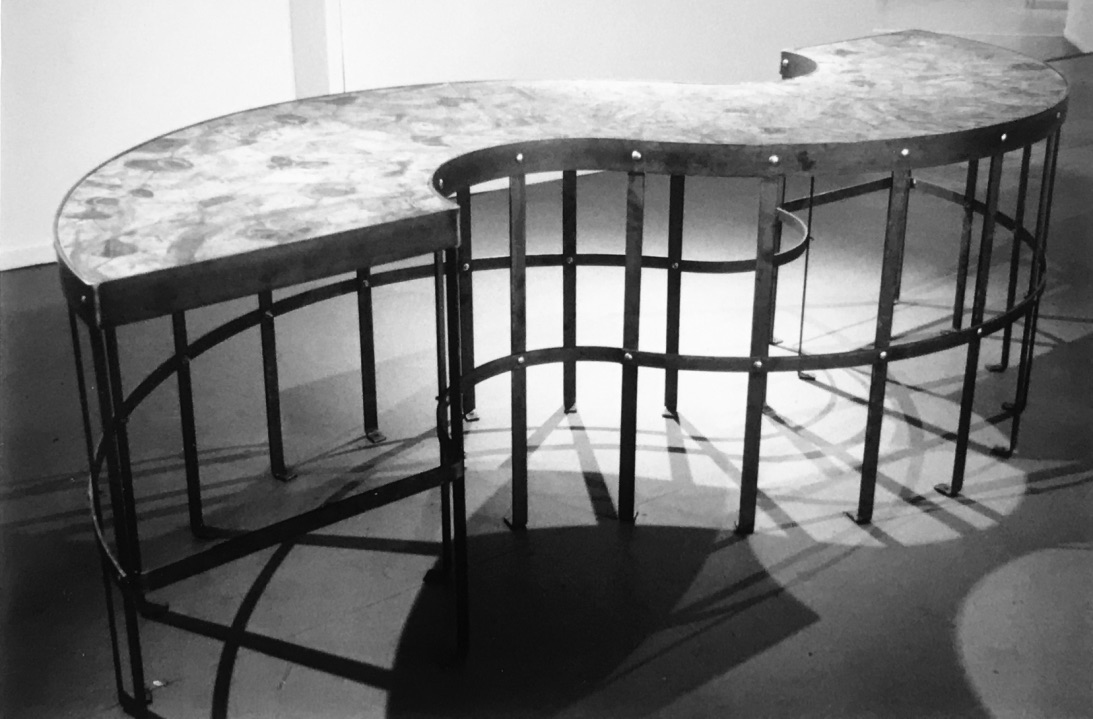
table des migrations
